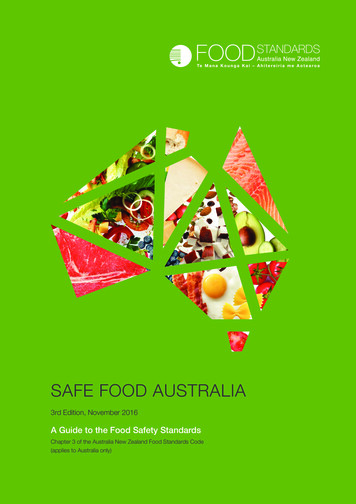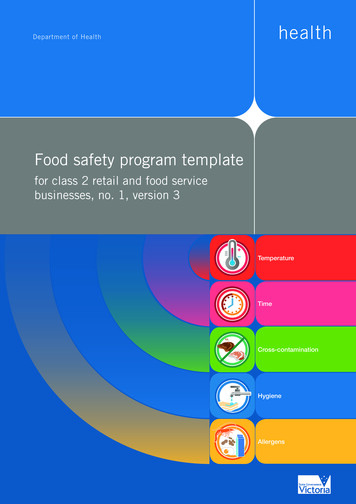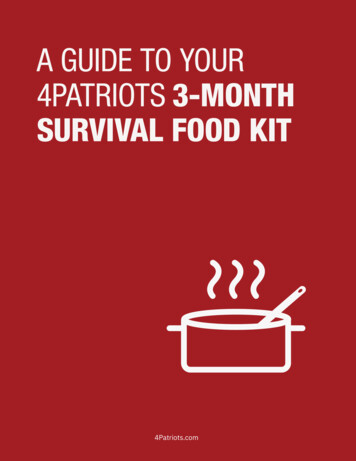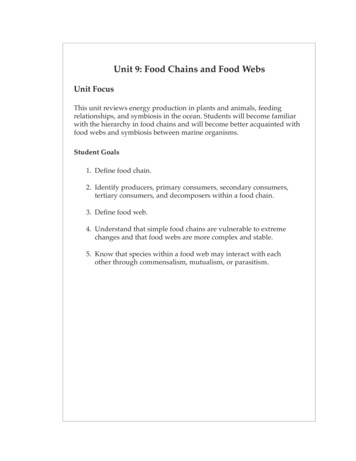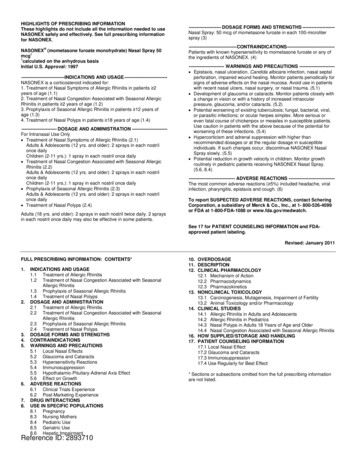
Transcription
HIGHLIGHTS OF PRESCRIBING INFORMATIONThese highlights do not include all the information needed to useNASONEX safely and effectively. See full prescribing informationfor NASONEX. NASONEX (mometasone furoate monohydrate) Nasal Spray 50†mcg†calculated on the anhydrous basisInitial U.S. Approval: 1997----------------------------INDICATIONS AND USAGE --------------------------- NASONEX is a corticosteroid indicated for:1. Treatment of Nasal Symptoms of Allergic Rhinitis in patients 2years of age (1.1)2. Treatment of Nasal Congestion Associated with Seasonal AllergicRhinitis in patients 2 years of age (1.2)3. Prophylaxis of Seasonal Allergic Rhinitis in patients 12 years ofage (1.3)4. Treatment of Nasal Polyps in patients 18 years of age (1.4)----------------------- DOSAGE AND ADMINISTRATION ---------------------- For Intranasal Use Only Treatment of Nasal Symptoms of Allergic Rhinitis (2.1)Adults & Adolescents (12 yrs. and older): 2 sprays in each nostrilonce dailyChildren (2-11 yrs.): 1 spray in each nostril once daily Treatment of Nasal Congestion Associated with Seasonal AllergicRhinitis (2.2)Adults & Adolescents (12 yrs. and older): 2 sprays in each nostrilonce dailyChildren (2-11 yrs.): 1 spray in each nostril once daily Prophylaxis of Seasonal Allergic Rhinitis (2.3)Adults & Adolescents (12 yrs. and older): 2 sprays in each nostrilonce daily Treatment of Nasal Polyps (2.4)Adults (18 yrs. and older): 2 sprays in each nostril twice daily. 2 spraysin each nostril once daily may also be effective in some patients.--------------------- DOSAGE FORMS AND STRENGTHS -------------------- Nasal Spray: 50 mcg of mometasone furoate in each 100-microliterspray S------------------------------ Patients with known hypersensitivity to mometasone furoate or any ofthe ingredients of NASONEX. (4)----------------------- WARNINGS AND PRECAUTIONS ---------------------- Epistaxis, nasal ulceration, Candida albicans infection, nasal septalperforation, impaired wound healing. Monitor patients periodically forsigns of adverse effects on the nasal mucosa. Avoid use in patientswith recent nasal ulcers, nasal surgery, or nasal trauma. (5.1) Development of glaucoma or cataracts. Monitor patients closely witha change in vision or with a history of increased intraocularpressure, glaucoma, and/or cataracts. (5.2) Potential worsening of existing tuberculosis; fungal, bacterial, viral,or parasitic infections; or ocular herpes simplex. More serious oreven fatal course of chickenpox or measles in susceptible patients.Use caution in patients with the above because of the potential forworsening of these infections. (5.4) Hypercorticism and adrenal suppression with higher thanrecommended dosages or at the regular dosage in susceptibleindividuals. If such changes occur, discontinue NASONEX NasalSpray slowly. (5.5) Potential reduction in growth velocity in children. Monitor growthroutinely in pediatric patients receiving NASONEX Nasal Spray.(5.6, 8.4)------------------------------ ADVERSE REACTIONS ----------------------------- The most common adverse reactions ( 5%) included headache, viralinfection, pharyngitis, epistaxis and cough. (6)To report SUSPECTED ADVERSE REACTIONS, contact ScheringCorporation, a subsidiary of Merck & Co., Inc., at 1- 800-526-4099or FDA at 1-800-FDA-1088 or www.fda.gov/medwatch.See 17 for PATIENT COUNSELING INFORMATION and FDAapproved patient labeling.Revised: January 2011FULL PRESCRIBING INFORMATION: CONTENTS*1.2.3.4.5.6.7.8.INDICATIONS AND USAGE1.1 Treatment of Allergic Rhinitis1.2 Treatment of Nasal Congestion Associated with SeasonalAllergic Rhinitis1.3 Prophylaxis of Seasonal Allergic Rhinitis1.4 Treatment of Nasal PolypsDOSAGE AND ADMINISTRATION2.1 Treatment of Allergic Rhinitis2.2 Treatment of Nasal Congestion Associated with SeasonalAllergic Rhinitis2.3 Prophylaxis of Seasonal Allergic Rhinitis2.4 Treatment of Nasal PolypsDOSAGE FORMS AND STRENGTHSCONTRAINDICATIONSWARNINGS AND PRECAUTIONS5.1 Local Nasal Effects5.2 Glaucoma and Cataracts5.3 Hypersensitivity Reactions5.4 Immunosuppression5.5 Hypothalamic-Pituitary-Adrenal Axis Effect5.6 Effect on GrowthADVERSE REACTIONS6.1 Clinical Trials Experience6.2 Post-Marketing ExperienceDRUG INTERACTIONSUSE IN SPECIFIC POPULATIONS8.1 Pregnancy8.3 Nursing Mothers8.4 Pediatric Use8.5 Geriatric Use8.6 Hepatic ImpairmentReference ID: 289371010. OVERDOSAGE11. DESCRIPTION12. CLINICAL PHARMACOLOGY12.1 Mechanism of Action12.2 Pharmacodynamics12.3 Pharmacokinetics13. NONCLINICAL TOXICOLOGY13.1 Carcinogenesis, Mutagenesis, Impairment of Fertility13.2 Animal Toxicology and/or Pharmacology14. CLINICAL STUDIES14.1 Allergic Rhinitis in Adults and Adolescents14.2 Allergic Rhinitis in Pediatrics14.3 Nasal Polyps in Adults 18 Years of Age and Older14.4 Nasal Congestion Associated with Seasonal Allergic Rhinitis16. HOW SUPPLIED/STORAGE AND HANDLING17. PATIENT COUNSELING INFORMATION17.1 Local Nasal Effect17.2 Glaucoma and Cataracts17.3 Immunosuppression17.4 Use Regularly for Best Effect* Sections or subsections omitted from the full prescribing informationare not listed.
FULL PRESCRIBING INFORMATION1.INDICATIONS AND USAGE1.1Treatment of Allergic Rhinitis NASONEX Nasal Spray 50 mcg is indicated for the treatment of the nasal symptoms of seasonal allergic and perennial allergic rhinitis, in adultsand pediatric patients 2 years of age and older.1.2Treatment of Nasal Congestion Associated with Seasonal Allergic RhinitisNASONEX Nasal Spray 50 mcg is indicated for the relief of nasal congestion associated with seasonal allergic rhinitis, in adults and pediatricpatients 2 years of age and older.1.3Prophylaxis of Seasonal Allergic RhinitisNASONEX Nasal Spray 50 mcg is indicated for the prophylaxis of the nasal symptoms of seasonal allergic rhinitis in adult and adolescentpatients 12 years and older.1.4Treatment of Nasal PolypsNASONEX Nasal Spray 50 mcg is indicated for the treatment of nasal polyps in patients 18 years of age and older.2.DOSAGE AND ADMINISTRATIONAdminister NASONEX Nasal Spray 50 mcg by the intranasal route only. Prior to initial use of NASONEX Nasal Spray, 50 mcg, the pump must beprimed by actuating ten times or until a fine spray appears. The pump may be stored unused for up to 1 week without repriming. If unused for more than1 week, reprime by actuating two times, or until a fine spray appears.2.1Treatment of Allergic RhinitisAdults and Adolescents 12 Years of Age and Older:The recommended dose for treatment of the nasal symptoms of seasonal allergic and perennial allergic rhinitis is 2 sprays (50 mcg ofmometasone furoate in each spray) in each nostril once daily (total daily dose of 200 mcg).Children 2 to 11 Years of Age:The recommended dose for treatment of the nasal symptoms of seasonal allergic and perennial allergic rhinitis is 1 spray (50 mcg ofmometasone furoate in each spray) in each nostril once daily (total daily dose of 100 mcg).2.2Treatment of Nasal Congestion Associated with Seasonal Allergic RhinitisAdults and Adolescents 12 Years of Age and Older:The recommended dose for treatment of nasal congestion associated with seasonal allergic rhinitis is two sprays (50 mcg of mometasonefuroate in each spray) in each nostril once daily (total daily dose of 200 mcg).Children 2 to 11 Years of Age:The recommended dose for treatment of nasal congestion associated with seasonal allergic rhinitis is one spray (50 mcg of mometasone furoatein each spray) in each nostril once daily (total daily dose of 100 mcg).2.3Prophylaxis of Seasonal Allergic RhinitisAdults and Adolescents 12 Years of Age and Older:The recommended dose for prophylaxis treatment of nasal symptoms of seasonal allergic rhinitis is 2 sprays (50 mcg of mometasone furoate ineach spray) in each nostril once daily (total daily dose of 200 mcg).In patients with a known seasonal allergen that precipitates nasal symptoms of seasonal allergic rhinitis, prophylaxis with NASONEX NasalSpray 50 mcg (200 mcg/day) is recommended 2 to 4 weeks prior to the anticipated start of the pollen season.2.4Treatment of Nasal PolypsAdults 18 Years of Age and Older:The recommended dose for the treatment of nasal polyps is 2 sprays (50 mcg of mometasone furoate in each spray) in each nostril twice daily(total daily dose of 400 mcg). A dose of 2 sprays (50 mcg of mometasone furoate in each spray) in each nostril once daily (total daily dose of 200 mcg) isalso effective in some patients.3.DOSAGE FORMS AND STRENGTHSNASONEX Nasal Spray 50 mcg is a metered-dose, manual pump spray unit containing an aqueous suspension of mometasone furoatemonohydrate equivalent to 0.05% w/w mometasone furoate calculated on the anhydrous basis.After initial priming (10 actuations), each actuation of the pump delivers a metered spray containing 100 mg or 100 microliter of suspensioncontaining mometasone furoate monohydrate equivalent to 50 mcg of mometasone furoate calculated on the anhydrous basis. Each bottle of NASONEXNasal Spray 50 mcg provides 120 sprays.4.CONTRAINDICATIONSNASONEX Nasal Spray is contraindicated in patients with known hypersensitivity to mometasone furoate or any of its ingredients.Reference ID: 28937102
5.WARNINGS AND PRECAUTIONS5.1Local Nasal EffectsEpistaxisIn clinical studies, epistaxis was observed more frequently in patients with allergic rhinitis with NASONEX Nasal Spray than those who receivedplacebo [see Adverse Reactions (6)].Candida InfectionIn clinical studies with NASONEX Nasal Spray 50 mcg, the development of localized infections of the nose and pharynx with Candida albicanshas occurred. When such an infection develops, use of NASONEX Nasal Spray 50 mcg should be discontinued and appropriate local or systemictherapy instituted, if needed.Nasal Septum PerforationInstances of nasal septum perforation have been reported following the intranasal application of corticosteroids. As with any long-term topicaltreatment of the nasal cavity, patients using NASONEX Nasal Spray 50 mcg over several months or longer should be examined periodically for possiblechanges in the nasal mucosa.Impaired Wound HealingBecause of the inhibitory effect of corticosteroids on wound healing, patients who have experienced recent nasal septum ulcers, nasal surgery,or nasal trauma should not use a nasal corticosteroid until healing has occurred.5.2Glaucoma and CataractsNasal and inhaled corticosteroids may result in the development of glaucoma and/or cataracts. Therefore, close monitoring is warranted inpatients with a change in vision or with a history of increased intraocular pressure, glaucoma, and/or cataracts.Glaucoma and cataract formation was evaluated in one controlled study of 12 weeks’ duration and one uncontrolled study of 12 months’ durationin patients treated with NASONEX Nasal Spray, 50 mcg at 200 mcg/day, using intraocular pressure measurements and slit lamp examination. Nosignificant change from baseline was noted in the mean intraocular pressure measurements for the 141 NASONEX-treated patients in the 12-weekstudy, as compared with 141 placebo-treated patients. No individual NASONEX-treated patient was noted to have developed a significant elevation inintraocular pressure or cataracts in this 12-week study. Likewise, no significant change from baseline was noted in the mean intraocular pressuremeasurements for the 139 NASONEX-treated patients in the 12-month study and again, no cataracts were detected in these patients. Nonetheless,nasal and inhaled corticosteroids have been associated with the development of glaucoma and/or cataracts.5.3Hypersensitivity ReactionsHypersensitivity reactions including instances of wheezing may occur after the intranasal administration of mometasone furoate monohydrate.Discontinue Nasonex Nasal Spray if such reactions occur [see Contraindications (4)].5.4ImmunosuppressionPersons who are on drugs which suppress the immune system are more susceptible to infections than healthy individuals. Chickenpox andmeasles, for example, can have a more serious or even fatal course in nonimmune children or adults on corticosteroids. In such children or adults whohave not had these diseases, particular care should be taken to avoid exposure. How the dose, route, and duration of corticosteroid administration affectthe risk of developing a disseminated infection is not known. The contribution of the underlying disease and/or prior corticosteroid treatment to the risk isalso not known. If exposed to chickenpox, prophylaxis with varicella zoster immune globin (VZIG) may be indicated. If exposed to measles, prophylaxiswith pooled intramuscular immunoglobulin (IG) may be indicated. (See the respective package inserts for complete VZIG and IG prescribinginformation.) If chickenpox develops, treatment with antiviral agents may be considered.Corticosteroids should be used with caution, if at all, in patients with active or quiescent tuberculous infection of the respiratory tract, or inuntreated fungal, bacterial, systemic viral infections, or ocular herpes simplex because of the potential for worsening of these infections.5.5Hypothalamic-Pituitary-Adrenal Axis EffectHypercorticism and Adrenal SuppressionWhen intranasal steroids are used at higher than recommended dosages or in susceptible individuals at recommended dosages, systemiccorticosteroid effects such as hypercorticism and adrenal suppression may appear. If such changes occur, the dosage of Nasonex Nasal Spray shouldbe discontinued slowly, consistent with accepted procedures for discontinuing oral corticosteroid therapy.5.6Effect on GrowthCorticosteroids may cause a reduction in growth velocity when administered to pediatric patients. Monitor the growth routinely of pediatricpatients receiving NASONEX Nasal Spray. To minimize the systemic effects of intranasal corticosteroids, including NASONEX Nasal Spray, titrate eachpatient’s dose to the lowest dosage that effectively controls his/her symptoms [see Use in Specific Populations (8.4)].6.ADVERSE REACTIONSSystemic and local corticosteroid use may result in the following: Epistaxis, ulcerations, Candida albicans infection, impaired wound healing [see Warnings and Precautions (5.1)] Cataracts and glaucoma [see Warnings and Precautions (5.2)] Immunosuppression [see Warnings and Precautions (5.4)] Hypothalamic-pituitary-adrenal (HPA) axis effects, including growth reduction [see Warnings and Precautions (5.5, 5.6), Use in SpecificPopulations (8.4)]6.1Clinical Trials ExperienceReference ID: 28937103
Because clinical trials are conducted under widely varying conditions, adverse reaction rates observed in the clinical trials of a drug cannot bedirectly compared to rates in the clinical trials of another drug and may not reflect the rates observed in practice.Allergic RhinitisAdults and adolescents 12 years of age and olderIn controlled US and international clinical studies, a total of 3210 adult and adolescent patients 12 years and older with allergic rhinitis receivedtreatment with NASONEX Nasal Spray 50 mcg at doses of 50 to 800 mcg/day. The majority of patients (n 2103) were treated with 200 mcg/day. Atotal of 350 adult and adolescent patients have been treated for one year or longer. Adverse events did not differ significantly based on age, sex, or race.Four percent or less of patients in clinical trials discontinued treatment because of adverse events and the discontinuation rate was similar for the vehicleand active comparators.All adverse events (regardless of relationship to treatment) reported by 5% or more of adult and adolescent patients ages 12 years and olderwho received NASONEX Nasal Spray 50 mcg, 200 mcg/day vs. placebo and that were more common with NASONEX Nasal Spray 50 mcg thanplacebo, are displayed in TABLE 1 below.TABLE 1: ADULT AND ADOLESCENT PATIENTS 12 YEARS AND OLDER – ADVERSE EVENTS FROM CONTROLLED CLINICAL TRIALS INSEASONAL ALLERGIC AND PERENNIAL ALLERGIC RHINITIS (PERCENT OF PATIENTS REPORTING)NASONEXVEHICLE200 mcgPLACEBO(n 2103)(n 1671)Headache2622Viral Mucus116Coughing76Upper Respiratory TractInfection62Dysmenorrhea535533Musculoskeletal PainSinusitisOther adverse events which occurred in less than 5% but greater than or equal to 2% of adult and adolescent patients (ages 12 years and older)treated with NASONEX Nasal Spray 50 mcg, 200-mcg/day (regardless of relationship to treatment), and more frequently than in the placebo groupincluded: arthralgia, asthma, bronchitis, chest pain, conjunctivitis, diarrhea, dyspepsia, earache, flu-like symptoms, myalgia, nausea, and rhinitis.Pediatric patients 12 years of ageIn controlled US and international studies, a total of 990 pediatric patients (ages 3 to 11 years) with allergic rhinitis received treatment withNASONEX Nasal Spray 50 mcg, at doses of 25 to 200 mcg/day. The majority of pediatric patients (n 720) were treated with 100 mcg/day. A total of163 pediatric patients have been treated for one year or longer. Two percent or less of patients in clinical trials who received NASONEX Nasal Spray 50mcg discontinued treatment because of adverse events and the discontinuation rate was similar for the placebo and active comparators.Adverse events which occurred in 5% of pediatric patients (ages 3 to 11 years) treated with NASONEX Nasal Spray 50 mcg, 100 mcg/day vs.placebo (regardless of relationship to treatment) and more frequently than in the placebo group included upper respiratory tract infection (5% inNASONEX Nasal Spray 50 mcg group vs. 4% in placebo) and vomiting (5% in NASONEX Nasal Spray 50 mcg group vs. 4% in placebo).Other adverse events which occurred in less than 5% but greater than or equal to 2% of pediatric patients (ages 3 to 11 years) treatedNASONEX Nasal Spray 50 mcg, 100 mcg/day vs. placebo (regardless of relationship to treatment) and more frequently than in the placebo groupincluded: diarrhea, nasal irritation, otitis media, and wheezing.The adverse event (regardless of relationship to treatment) reported by 5% of pediatric patients ages 2 to 5 years who received NASONEXNasal Spray, 50 mcg, 100 mcg/day in a clinical trial vs. placebo including 56 subjects (28 each NASONEX Nasal Spray, 50 mcg and placebo) and thatwas more common with NASONEX Nasal Spray, 50 mcg than placebo, included: upper respiratory tract infection (7% vs. 0%, respectively). The otheradverse event which occurred in less than 5% but greater than or equal to 2% of mometasone furoate pediatric patients ages 2 to 5 years treated with100 mcg doses vs. placebo (regardless of relationship to treatment) and more frequently than in the placebo group included: skin trauma.Nasal PolypsAdults 18 years of age and olderIn controlled clinical studies, the types of adverse events observed in patients with nasal polyps were similar to those observed for patients withallergic rhinitis. A total of 594 adult patients (ages 18 to 86 years) received NASONEX Nasal Spray 50 mcg at doses of 200 mcg once or twice daily forReference ID: 28937104
up to 4 months for treatment of nasal polyps. The overall incidence of adverse events for patients treated with NASONEX Nasal Spray 50 mcg wascomparable to patients with the placebo except for epistaxis, which was 9% for 200 mcg once daily, 13% for 200 mcg twice daily, and 5% for theplacebo.Nasal ulcers and nasal and oral candidiasis were also reported in patients treated with NASONEX Nasal Spray 50 mcg primarily in patientstreated for longer than 4 weeks.Nasal Congestion Associated with Seasonal Allergic RhinitisA total of 1008 patients aged 12 years and older received NASONEX Nasal Spray 50 mcg 200 mcg/day (n 506) or placebo (n 502) for 15days. Adverse events that occurred more frequently in patients treated with NASONEX Nasal Spray 50 mcg than in patients with the placebo includedsinus headache (1.2% in NASONEX Nasal Spray 50 mcg group vs. 0.2% in placebo) and epistaxis (1% in NASONEX Nasal Spray 50 mcg group vs.0.2% in placebo) and the overall adverse event profile was similar to that observed in the other allergic rhinitis trials.6.2Post-Marketing ExperienceThe following adverse reactions have been identified during the post-marketing period for NASONEX Nasal Spray 50 mcg: nasal burning andirritation, anaphylaxis and angioedema, disturbances in taste and smell and nasal septal perforation. Because these reactions are reported voluntarilyfrom a population of uncertain size, it is not always possible to reliably estimate their frequency or establish a causal relationship to drug exposure.7.DRUG INTERACTIONSNo formal drug-drug interaction studies have been conducted with NASONEX Nasal Spray 50 mcg.Inhibitors of Cytochrome P450 3A4: Studies have shown that mometasone furoate is primarily and extensively metabolized in the liver of allspecies investigated and undergoes extensive metabolism to multiple metabolites. In vitro studies have confirmed the primary role of cytochrome CYP3A4 in the metabolism of this compound. Coadministration with ketoconazole, a potent CYP 3A4 inhibitor, may increase the plasma concentrations ofmometasone furoate [see Clinical Pharmacology (12.3)].8.USE IN SPECIFIC POPULATIONS8.1PregnancyTeratogenic Effects: Pregnancy Category C: There are no adequate and well-controlled studies in pregnant women. NASONEX Nasal Spray 50 mcg,like other corticosteroids, should be used during pregnancy only if the potential benefits justify the potential risk to the fetus. Experience with oralcorticosteroids since their introduction in pharmacologic, as opposed to physiologic, doses suggests that rodents are more prone to teratogenic effectsfrom corticosteroids than humans. In addition, because there is a natural increase in corticosteroid production during pregnancy, most women willrequire a lower exogenous corticosteroid dose and many will not need corticosteroid treatment during pregnancy.2In mice, mometasone furoate caused cleft palate at subcutaneous doses (less than the MRDID in adults on a mcg/m basis). Fetal survival was22reduced at approximately 2 times the MRDID in adults on a mcg/m basis. No toxicity was observed at less than the MRDID in adults on a mcg/m basis.2In rats, mometasone furoate produced umbilical hernia at topical dermal doses approximately 10 times the MRDID in adults on a mcg/m basis.2A topical dermal dose approximately 6 times the MRDID in adults on a mcg/m basis produced delays in ossification, but no malformations.In rabbits, mometasone furoate caused multiple malformations (e.g., flexed front paws, gallbladder agenesis, umbilical hernia, and hydrocephaly)2at topical dermal doses approximately 6 times the MRDID in adults on a mcg/m basis. In an oral study, mometasone furoate increased resorptions and2caused cleft palate and/or head malformations (hydrocephaly or domed head) at approximately 30 times the MRDID in adults on a mcg/m basis. At2approximately 110 times the MRDID in adults on a mcg/m basis, most litters were aborted or resorbed. No toxicity was observed at approximately 62times the MRDID in adults on a mcg/m basis.When rats received subcutaneous doses of mometasone furoate throughout pregnancy or during the later stages of pregnancy, a dose less than2the MRDID in adults on a mcg/m basis caused prolonged and difficult labor and reduced the number of live births, birth weight, and early pup survival.Nonteratogenic Effects: Hypoadrenalism may occur in infants born to women receiving corticosteroids during pregnancy. Such infants shouldbe carefully monitored.8.3Nursing MothersIt is not known if mometasone furoate is excreted in human milk. Because other corticosteroids are excreted in human milk, caution should beused when NASONEX Nasal Spray, 50 mcg is administered to nursing women.8.4Pediatric UseThe safety and effectiveness of NASONEX Nasal Spray 50 mcg for allergic rhinitis in children 12 years of age and older have been established[see Adverse Reactions (6.1) and Clinical Studies (14.1)]. Use of NASONEX Nasal Spray 50 mcg for allergic rhinitis in pediatric patients 2 to 11 years ofage is supported by safety and efficacy data from clinical studies. Seven hundred and twenty (720) patients 3 to 11 years of age with allergic rhinitiswere treated with mometasone furoate nasal spray 50 mcg (100 mcg total daily dose) in controlled clinical trials [see Adverse Reactions (6.1) andClinical Studies (14.2)]. Twenty-eight (28) patients 2 to 5 years of age with allergic rhinitis were treated with mometasone furoate nasal spray 50 mcg(100 mcg total daily dose) in a controlled trial to evaluate safety [see Adverse Reactions (6.1)]. Safety and effectiveness of Nasonex Nasal Spray 50 mcgfor allergic rhinitis in children less than 2 years of age have not been established.The safety and effectiveness of Nasonex Nasal Spray for the treatment of nasal polyps in children less than 18 years of age have not beenestablished. One 4-month trial was conducted to evaluate the safety and efficacy of Nasonex in the treatment of nasal polyps in pediatric patients 6 to 17years of age. The primary objective of the study was to evaluate safety; efficacy parameters were collected as secondary endpoints. A total of 127patients with nasal polyps were randomized to placebo or Nasonex Nasal Spray 100 mcg once or twice daily (patients 6 to 11 years of age) or 200 mcgonce or twice daily (patients 12 to 17 years of age). The results of this trial did not support the efficacy of Nasonex Nasal Spray in the treatment of nasalReference ID: 28937105
polyps in pediatric patients. The adverse events reported in this trial were similar to the adverse events reported in patients 18 years of age and olderwith nasal polyps.Controlled clinical studies have shown intranasal corticosteroids may cause a reduction in growth velocity in pediatric patients. This effect hasbeen observed in the absence of laboratory evidence of hypothalamic-pituitary-adrenal (HPA) axis suppression, suggesting that growth velocity is amore sensitive indicator of systemic corticosteroid exposure in pediatric patients than some commonly used tests of HPA axis function. The long-termeffects of this reduction in growth velocity associated with intranasal corticosteroids, including the impact on final adult height, are unknown. Thepotential for “catch up” growth following discontinuation of treatment with intranasal corticosteroids has not been adequately studied. The growth ofpediatric patients receiving intranasal corticosteroids, including NASONEX Nasal Spray, 50 mcg, should be monitored routinely (e.g., via stadiometry).The potential growth effects of prolonged treatment should be weighed against clinical benefits obtained and the availability of safe and effectivenoncorticosteroid treatment alternatives. To minimize the systemic effects of intranasal corticosteroids, including NASONEX Nasal Spray, 50 mcg, eachpatient should be titrated to his/her lowest effective dose.A clinical study to assess the effect of NASONEX Nasal Spray 50 mcg (100 mcg total daily dose) on growth velocity has been conducted inpediatric patients 3 to 9 years of age with allergic rhinitis. No statistically significant effect on growth velocity was observed for NASONEX Nasal Spray50 mcg compared to placebo following one year of treatment. No evidence of clinically relevant HPA axis suppression was observed following a 30 minute cosyntropin infusion.The potential of NASONEX Nasal Spray 50 mcg to cause growth suppression in susceptible patients or when given at higher doses cannot beruled out.8.5Geriatric UseA total of 280 patients above 64 years of age with allergic rhinitis or nasal polyps (age range 64 to 86 years) have been treated with NASONEXNasal Spray 50 mcg for up to 3 or 4 months, respectively. The adverse reactions reported in this population were similar in type and incidence to thosereported by younger patients.8.6Hepatic ImpairmentConcentrations of mometasone furoate appear to increase with severity of hepatic impairment [see Clinical Pharmacology (12.3)]10.OVERDOSAGEThere are no data available on the effects of acute or chronic overdosage with NASONEX Nasal Spray 50 mcg. Because of low systemic bioavailability,and an absence of acute drug-related systemic findings in clinical studies, overdose is unlikely to require any therapy other than observation. Intranasaladministration of 1600 mcg (4 times the recommended dose of NASONEX Nasal Spray 50 mcg for the treatment of nasal polyps in patients 18 years ofage and older) daily for 29 days, to healthy human volunteers, showed no increased incidence of adverse events. Single intranasal doses up to 4000mcg and oral inhalation doses up to 8000 mcg have been studied in human volunteers with no adverse effects reported. Chronic over dosage with anycorticosteroid may result in signs or symptoms of hypercorticism [see Warnings and Precautions (5.4)]. Acute overdosage with this dosage form isunlikely since one bottle of NASONEX Nasal Spray 50 mcg contains approximately 8500 mcg of mometasone furoate.11.DESCRIPTIONMometasone furoate monohydrate, the active component of NASONEX Nasal Spray, 50 mcg, is an anti-inflammatory corticosteroid having thechemical name, 1,4-diene-3,20-dione17-(2 furoate) monohydrate, and the following chemicalstructure:Mometasone furoate monohydrate is a white powder, with an empirical formula of C27H30Cl2O6 H2O, and a molecular weight of 539.45. It ispractically insoluble in water; slightly soluble in methanol, ethanol, and isopropanol; soluble in acetone and chloroform; and freely soluble intetrahydrofuran. Its partition coefficient between octanol and water is greater than 5000.NASONEX Nasal Spray 50 mcg is a metered-dose, manual pump spray unit containing an aqueous suspension of mometasone furoatemonohydrate equivalent to 0.05% w/w mometasone furoate calculated on the anhydrous basis; in an aqueous medium containing glycerin,microcrystalline cellulose and carboxymethylcellulo
FULL PRESCRIBING INFORMATION . 1. INDICATIONS AND USAGE 1.1 . Treatment of Allergic Rhinitis . NASONEX Nasal Spray 50 mcg is indicated for the treatment of the nasal symptoms of seasonal allergic and perennial allergic rhinitis, in adults and pediatric patients 2 years of age and older.




